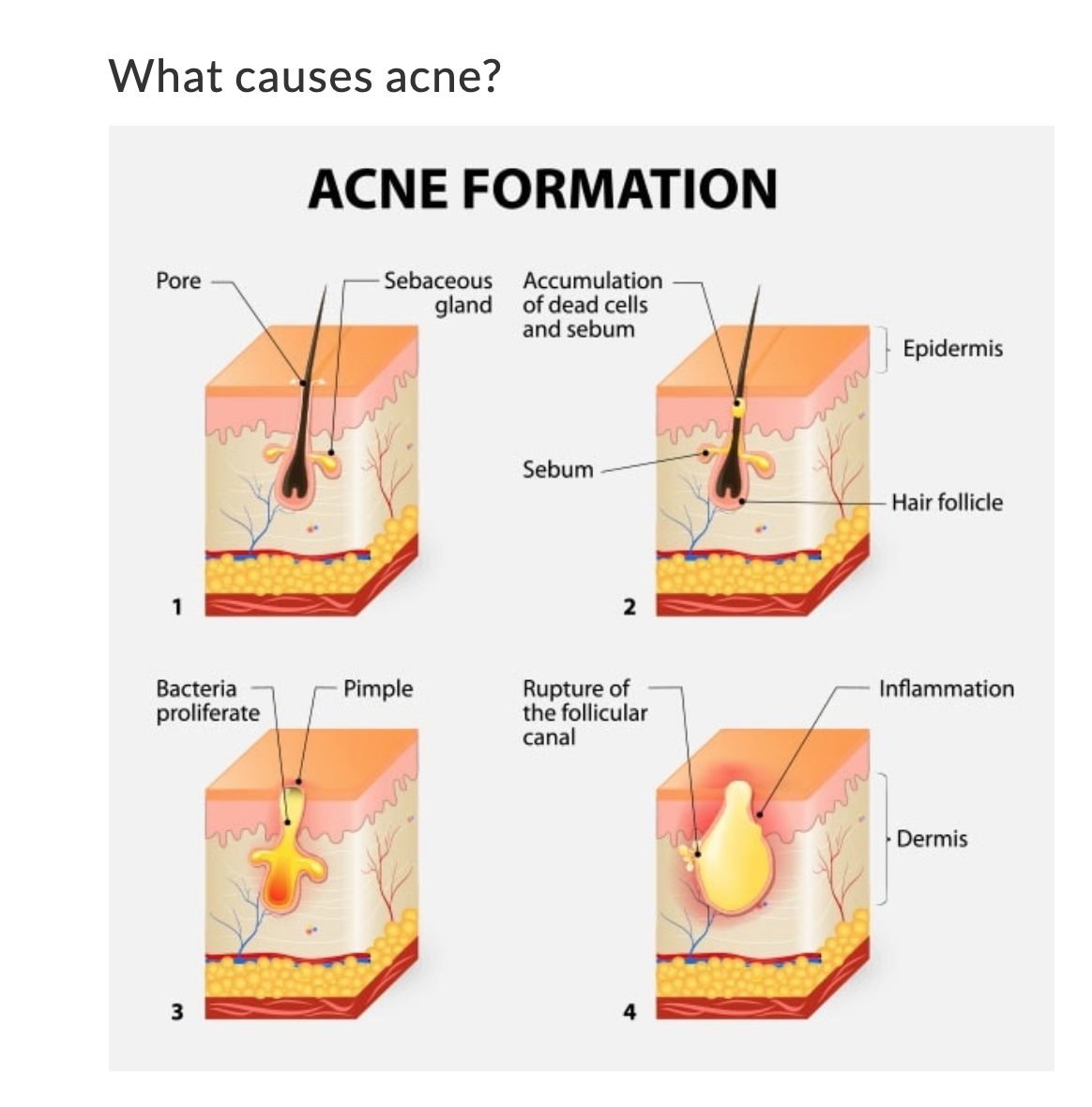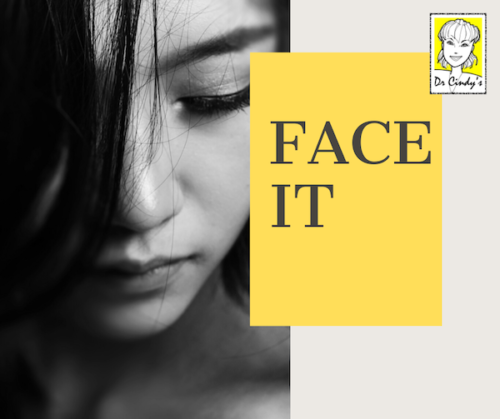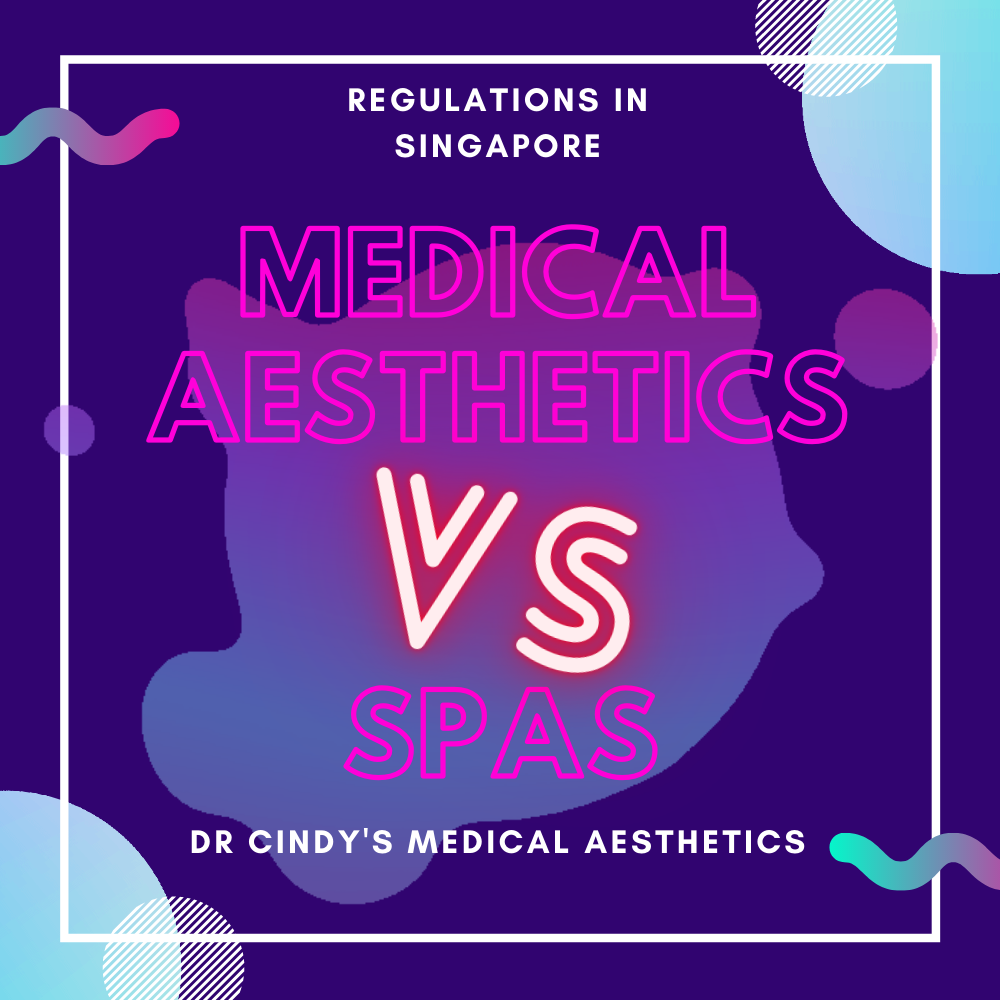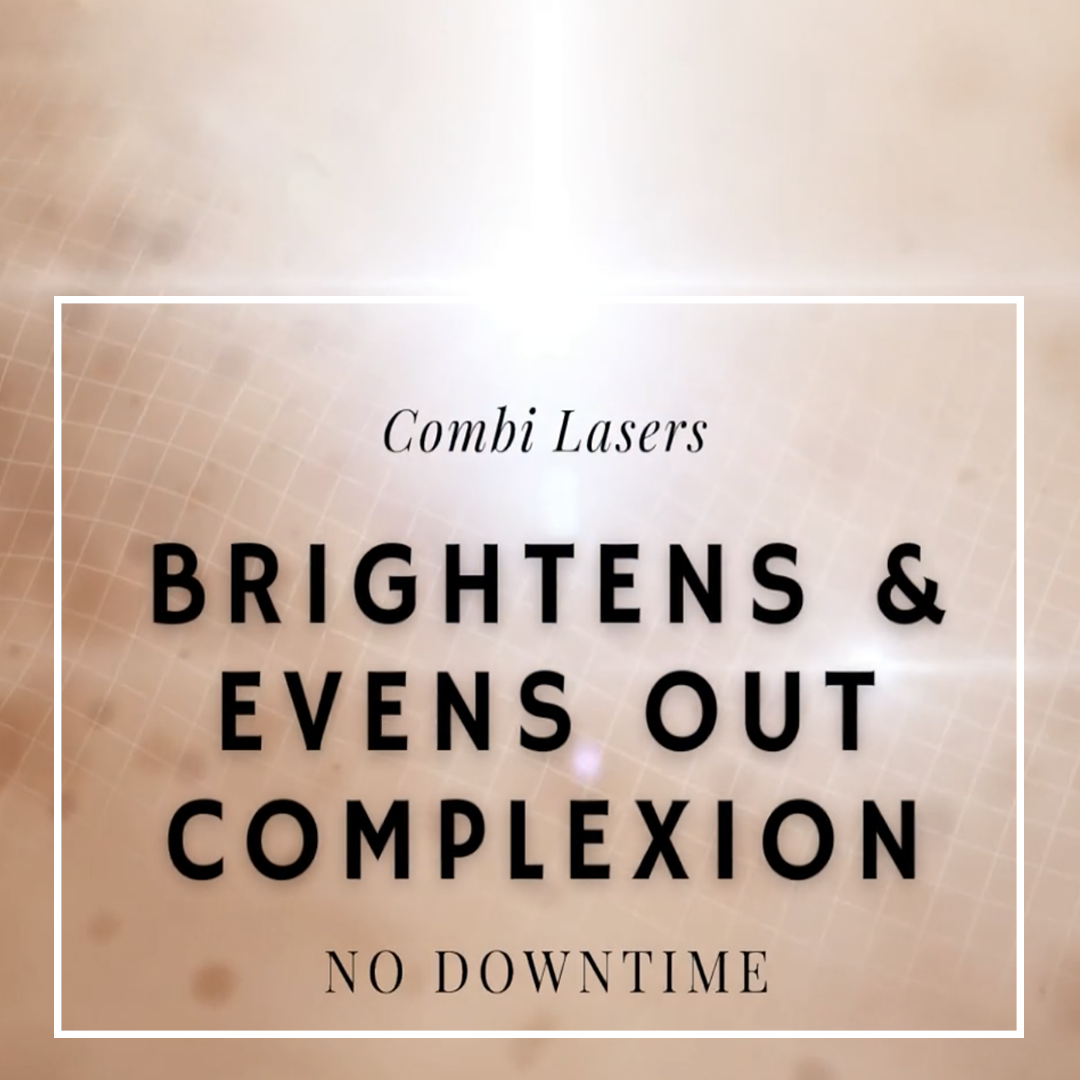Types of Acne and its Cure
Acne or Pimples?
Acne is a broad term that encompasses a variety of skin ailments that ranges in varying degree of severity. It can be an occasional pimple or zit, or it can be a full-blown cystic inflammation with uncountable boils covering the whole face. We need to identify the types of acne and its cure, as this seemingly innocuous condition can cause significant adverse psychological effects including lowered self-esteem, anxiety and in some cases, depression. Interestingly, it affects everyone at some point in their lives, from teens right up to adulthood.
How Acne Develops

Acne starts when sebaceous glands in the skin get inflamed or infected.
Acne starts when sebaceous glands in the skin get inflamed or infected. Acne vulgaris is a broad medical term commonly used When hair follicles become congested with excess sebum, germs and dead skin cells, a clogged pore forms which lead to acne vulgaris forms.
Old skin cells slough off as the skin regenerates. However, if these dead skin cells do not slough off due to the oily milieu, the whole complex then congests the pores. When combined with sweat and oil, these become blackheads, whiteheads, papules, pustules, blemishes, and cysts. With the entry of bacteria, pimples forms when the pore becomes inflamed. Let me detail the types of acne and its cure.
Blackheads
Blackheads are open comedones. The trapped sebum complex (made of debris and oil accumulation) within the pores when exposed to air, there is oxidation on the skin surface, and hence the whole sebum complex turns black, These usually form on the face, neck, chest, and back.
Whiteheads and Milia Seeds
Whiteheads are ‘blocked’ follicles made up of the same trapped debris and oil accumulation. Covered by a thin layer of skin, there is no contact with air and hence no oxidation. So the colour remains white and appears as white bumps or spots that are generally deeper within the skin than blackheads.
Papules
Papules are swollen red sores and can be painful and sensitive.
It might be tempting to extract their pus by popping these lesions. However, popping these pustules can lead to long term acne scarring, if the method of removal is incorrect or unhygienic.

Acne, pimple, blackheads and whiteheads need different treatments
Nodules
Nodules are acne lesions that develop deeper under the skin. They are generally lumpy and do not contain pus. This type of acne lesions can enlarge to be 1 to 2 centimetres in size and are rather painful to touch.
Cysts
Cysts are a severe kind of acne lesions that are both swollen and filled with pus, with a high degree of inflammation within.
They can be very painful and may need professional medical treatment such as steroid injections.
What Causes Acne?
* Genetic history of Acne within the family  * Excessive androgen hormone
* Excessive androgen hormone
* Too much oil production
* Presence of P.acne bacteria
Some factors above are not within our control. Proper skin management and professional treatments can prevent and curb acne flare-ups. Simple changes to your skincare routine can help—learning how to wash your face regularly and adequately with an effective cleanser can help clear your face of debris and excess oil production. We at Dr Cindy’s Medical Aesthetics are experienced with the types of acne and its cure.
Genetic Factors
Genetics can also affect Acne. Teens whose parents have dealt with Acne in their youth are most likely to battle this same skin problem. While it is not a genetic disease, hereditary elements are to Acne.
Hormonal Changes
The onset of puberty causes the hormonal levels to fluctuate, Androgen levels rise, causing the skin glands to begin producing more significant amounts of sebum. This type of Acne is Hormonal Acne.
Puberty is not the only stage in life that we experience hormonal changes. Women experience regular variations in hormone levels, precisely that of estrogen and androgen. Hormonal fluctuations are typical with menstrual cycles, but also with pregnancy and even later on in life nearing menopause.
Men also experience hormone level fluctuations, especially in their teens, but this usually mellows out by adulthood.
Stress
It is a well-known fact that stress can trigger a breakout. Whether it is examinations, a change of environment or a new job, there is a physiological response that connects stress to different types of Acne. Under stress, the body releases hormones such as cortisol and adrenaline. When these hormones fluctuate, your skin secretes more oil, which can bring on a breakout or worsen an existing condition.
Types of Acne and Treatments
Now that we understand how Acne develops and the different kinds of Acne, we need answers to the vital question: what kind of Acne do I have?
We can classify acne lesions into 2 main types: Inflammatory and Non-inflammatory Acne.
Non-inflammatory Acne is typically comedones, which can be open or closed. These comedones are blackheads (closed comedones) and whiteheads (open comedones). Self-extraction of comedones can trigger more damage than improvement. This reason being the follicle walls in blackheads and whiteheads can be ruptured rather easily with the wrong extraction technique. Once ruptured, germs can enter the surrounding pores, which leads to inflamed Acne.
Extracting Acne at home could trigger:
Worsened Acne
More agonizing Acne
Infected Acne
Inflammatory Acne
Permanent Scarring
Inflammatory breakouts can be a result of P. Acnes bacteria infecting the remaining roots that were not cleanly extracted out, thus triggering a reaction from the body that can cause acne breakouts, leading to the four types of inflammatory Acne which are blemishes, papules, cysts, pustules (in terms of severity)
Is the Type of Acne I Have Considered Severe?

Severity Grades
When it comes to medical acne diagnosis, acne vulgaris is measured on grades of seriousness and categorized into mild, moderate, and severe. Mild Acne is characterized by a small number of acne lesions (less than 20 comedones and 15 lesions). These lesions are also typically small in size. Moderate Acne has typically in between 20 and 100 comedones, and 15 to 50 inflammatory lesions. Severe Acne is when cystic sores are present on top of comedones and surface-level lesions.
Learn to manage your skin better, start by knowing the types of acne and its cure.
Topical Medications
The most common topical prescription medications for acne are:
*Retinoids and retinoid-like drugs.
They come in various forms such as creams, gels and lotions.
Retinoid drugs are derived from vitamin A and include; Tretinoin (Avita, Retin-A and others), Adapalene (Differin) and Tazarotene (Tazorac, Averge)
Patients typically start by applying them three times a week in the beginning, then daily as your skin becomes used to it. It works by preventing plugging of the hair follicles.
Antibiotics
Antibiotics work by killing excess skin bacteria and calms inflammation. The antibiotics are often combined with benzoyl peroxide to reduce the likelihood of developing antibiotic resistance. Examples include clindamycin with benzoyl peroxide (Benzaclin, Duac, Acanya) and erythromycin with benzoyl peroxide (Benzamycin).
Salicylic Acid
Salicylic acid may help prevent clogged hair follicles and is available as both wash-off and leave-on products. However, clinical studies have shown that its effectiveness is limited. Long term use may also cause skin sensitivity.
Cyspera®
Cyspera ® is a biological depigmenting treatment for dark spots and hyperpigmentation issues. Cyspera® contains Cysteamine, a natural biological ingredient that lowers melanin pigments in human skin cells. Popularly known as a topical treatment cure for pigmentation and melasma, it is efficient in preventing fresh acne scars from turning dark and even helps to lighten old acne scars.
Antibiotics
For moderate to severe acne, doctors may prescribe oral antibiotics to fight bacteria and reduce inflammation. The most common antibiotic for treating Acne is tetracycline — such as minocycline or doxycycline. Oral antibiotics should be used for a short course to prevent antibiotic resistance. Antibiotics may cause side effects, such as an upset stomach and dizziness. Antibiotics usually are used with topical retinoids or benzoyl peroxide. Studies have found that using topical benzoyl peroxide, along with oral antibiotics, may reduce the risk of developing antibiotic resistance. These drugs also increase your skin’s sensitivity to the sun.
Oral Contraceptives
There are Four combined oral contraceptives are approved by the FDA for acne therapy in women; who also wish to use them for contraception. These oral contraceptive products contain estrogen and progestin; popular brands are Diane 35, Yaz and Yasmine. One can see some results only after some months; some side effects of oral contraceptives drugs are weight gain, tenderness in the breast area and nausea. A serious potential complication is a slightly increased risk of blood embolisms.
Isotretinoin
Isotretinoin comes in a few brands best known under the brand name Accutane. Is a powerful acne medication and works when all other acne treatments have failed. However, it is an expensive medication. Because of its potential side effects, patients need to sign a consent form and doctors need to monitor patients on this medication closely. The most common side effects are dryness of the skin, eyes, mouth, lips, nose and scalp. Other side effects include nosebleeds, aching, diminished night vision, sun sensitivity, and changes in triglyceride levels and impaired liver function. Patients taking isotretinoin need periodic blood tests. Increased risk of depression and possible severe congenital disabilities makes parents wary of having this mediation prescribed for their teens. Young adults who are starting their family should also take note of this teratogenic risk.
Aesthetics Therapies
These therapies may be suggested in select cases, either alone or in combination with medications or products.
*Regular Medical Facials
Our therapists use special tools to remove whiteheads and blackheads gently. The chances of scarring are also significantly reduced as the extraction process is immediately followed by disinfecting and calming light therapy in our treatment cabin, thus reducing the inflammatory process.
Chemical Peels
Superficial layer and medium depth peels at the clinics have gained popularity in the treatment of acne vulgaris as it is a relatively low cost and very safe procedure. They target many of the pathophysiological aspects involved in acne vulgaris. Chemical peels break down dead skin cells with subsequent exfoliation, induce keratolysis, and have comedolytic results. It also reduces sebum production and shrink pore size, and have antibacterial and anti-inflammatory effects. Chemical peels promote the penetration and absorption of other topical Acne treatments or skin care products by minimizing the barrier impact of the stratum corneum. The most commonly utilized medium and superficial depth peeling agents are:
- Glycolic Acid– derives from sugar cane, benefits oily and typical skin types. It exfoliates the surface layer of your skin and effectively removes dead skin cells and keratin.
- Salicylic Acid– is excellent for oily and acne-prone skin to unclog dirt from pores. It is an effective form of deep cleansing.
- Lactic Acid – a component of milk, benefits all skin types and for fading pigmentation and dark spots. It promotes radiance and luminosity
- Mandelic acid – benefits all skin types, especially darker complexion. It does a great job in shrinking big pores size.
- Phytic Acid – excellent for delicate skin and post-inflammatory hyperpigmentation, tolerable even by sensitive skins
Chemical Peels can treat the skin on the body, namely the neck, the chest and the back. Chemical Peels makes extraction much more comfortable and in some cases, even not necessary at all. In Singapore’s tropical humid climate, regular peels are almost a necessity to ensure the freshest layers of skin cells on the top, that is first criteria to a fresh and radiant complexion.
Lasers and Photodynamic Therapy
Nd: YAG laser
Nd: YAG laser light safely penetrates the skin to target overactive sebaceous glands and to reduce the risk of developing new acne inflammation. For active Acne, Nd: YAG laser treatment reduces acne inflammation through photoselective absorption and controlled heating effects.
Erbium Glass Laser
Using a fractional Er:Glass laser, mid-infrared wavelength is sent deep within the skin to resurface and deliver non-ablative dermal remodelling. The laser shrinks sebaceous glands in affected areas while simultaneously encouraging the regeneration of new dermal tissues. When the healing process is complete, visibly smoother skin will be seen.
Brightening Laser / Acne Red Mark Laser Laser
Brightening Laser / Acne Red Mark Laser Laser utilizes the most sophisticated laser to supply optimum skin restoration treatment with minimal pain and adverse effects. The green and yellow light can help resolve various skin problems which include Acne. Brightening Laser / Acne Red Mark Laser Laser is a non-ablative laser treatment that does not burn away any skin; it positively impacts the surrounding skin outside the targeted lesion. This intelligent light laser is capable of specifical targets and destroys Protoporphorian IX, the bacteria that causes Acne. The yellow light wavelength also helps to calm the inflamed acne sores, hence reducing the redness of Acne.
Steroid Injection
Steroid shots are an emergency solution, not a regular treatment. These steroid injections are usually reserved as a last resort for a painful, cystic nodule that is not improving, or in an ’emergency’ setting when you need a pimple to resolve quickly for an important upcoming event.
It can also help redeem prominent, painful lesions that might lead to a scar. Cortisone shots are injections of a synthetic hormone. It provides fast relief of inflammation, and this helps to shrink large acne cysts. Done in the clinic, cortisone shots can help reduce the redness, swelling, and pain of severe inflammatory acne breakouts within a few days.
Having explained the types of acne and its cure and all the medical avenues above, Dr Cindy’s Medical Aesthetics employs a gentle program with a holistic approach; This means the integrated use of topicals, nutrition and laser therapies in our acne control programme with minimal side effects and evident results. We take utmost priority in caring for our acne patients by accurately diagnose the types of acne and its cure. If you are facing an acne issue, the next thing you need to do is to have a meeting with our doctors to diagnose your acne problem accurately. Tackle acne issues as early as possible and do not let the inflammation run wild. We have 3 clinics located across Singapore in Orchard, Tampines and Jurong. Kindly make an appointment at one of our clinics near you.
By Dr Cindy Yang
Dr Cindy Medical Aesthetics is listed as 6 Best Clinics For Acne Scar Removal Treatment In Singapore
Call Us & Book an Appointment:
+65 6733 4433

 01 May 2020
01 May 2020









